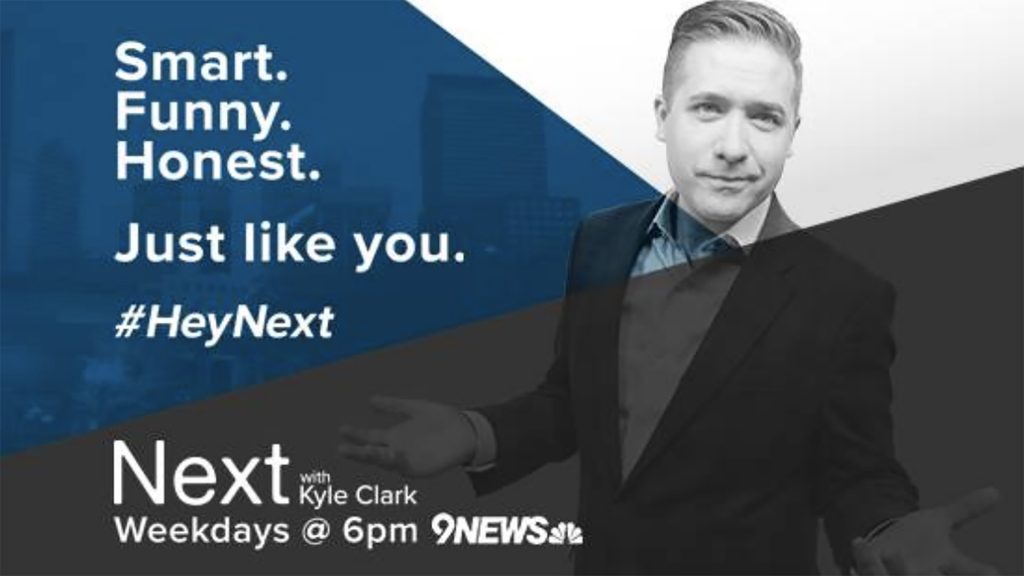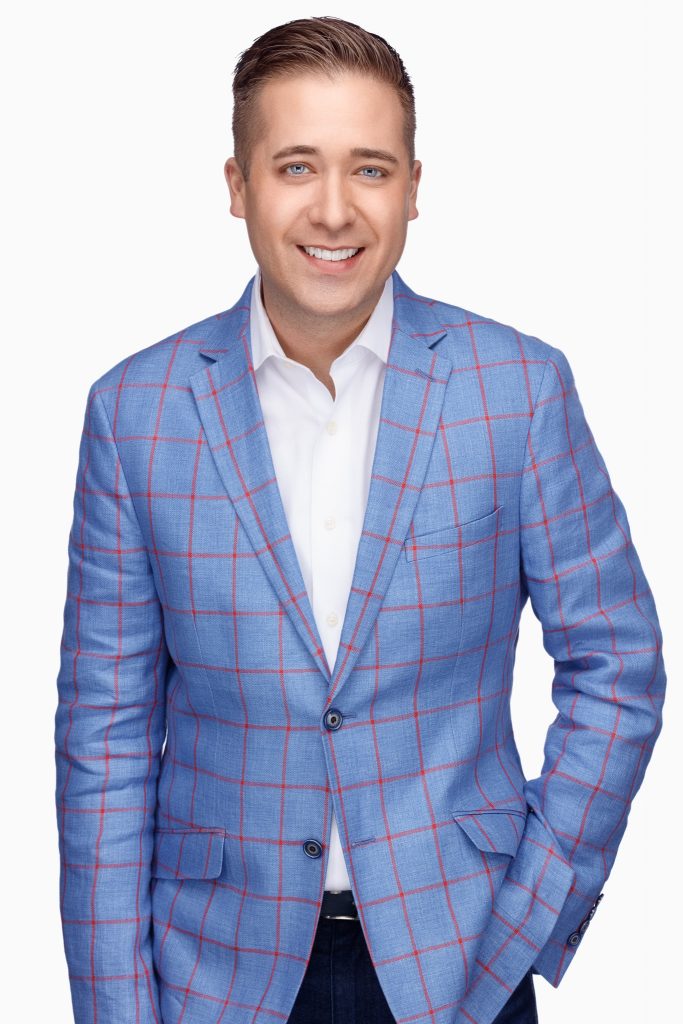
Hey boss, got a second? I’ve got a great idea. Let’s take our 6 PM News — yes, I know it’s #1 in the market — and blow it up. Let’s get rid of murders, fires and car crashes unless they’re really bad — no more “flashing light” coverage. Let’s pare back the set and most of the graphics. Let’s not worry at all about what stories the competition is doing — no more “broadcast of record” stuff. We’ll just do what we think is important and/or interesting — and most of all, different. Oh, did I mention that I’ll be the solo anchor? My co-anchor is retiring soon anyway. And I’m going to throw in my opinion from time to time — not just the facts. What do you say?
That was pretty much the pitch KUSA-TV Denver anchor Kyle Clark, made to TEGNA president Dave Lougee and other corporate executives at one of the company’s innovation summits in 2015. Obviously, Lougee said yes, or you wouldn’t be reading this. Next with Kyle Clark went on the air in August of 2016.
What happened next wasn’t pretty — downright ugly in fact. As many news executives have found out the hard way, it’s a lot easier to drive existing viewers away than to attract new ones — one of the reasons innovation is so challenging. Next “generated more buzz than ratings” in its first November book, wrote the Denver Post’s respected TV reporter and critic Joanne Ostrow in December of 2016. The program was down nearly 40% — yikes! — from its predecessor in the time period, threatening KUSA’s traditional dominance. Ostrow wondered, “Is it possible the innovation has alienated viewers who prefer a classic newscast?”
Despite the vertiginous ratings drop, TEGNA executives stuck with the format, and Clark stuck with Next’s unorthodox formula. There’s only a handful of reporter packages, which lean towards civics and away from sensationalism. “We’re not going to chase every shiny object just because we can put a helicopter over it,” says Clark, who also serves as Next’s managing editor. The weather person often gets a minute or less, with little or no banter. Linda Kotsaftis, KUSA’s head of news content, who developed the concept with Clark and still works closely with him, recalls a routine snowfall early in Next’s run when the program devoted just 15 seconds to weather, and she looked up to see the station’s competitors fielding multiple reporters to cover the “storm.” “I was surprised that people didn’t raise their pitchforks and say, ‘Why don’t you have someone standing by the side of the road?’”
But they didn’t. It turned out that at least some viewers were ready for something new and different, in this case a program that spoke to them directly and, even more importantly, listened. “The viewer is the co-anchor, and not in a check-the-box way,” says Clark. “We rely on their collaboration throughout the day.” Indeed, Next’s relationship with its viewers is a critical ingredient in the special sauce. ”We didn’t realize what a big part of the show the audience would become,” says Kotsaftis. “The show is built around [Kyle], but it’s also built around really strong writing, looking for unique content every day, and it’s become hugely about the back and forth with the audience,”
Next’s viewers constantly get on-air credit, not just for suggesting enterprise stories but for contributing to franchises like “The Most Colorado Thing We Saw Today” (e.g. fanatical golfers shoveling snow off a putting green), “Crossing the Line” (photos of cars shamelessly parked in traffic lanes); “It’s a Sign” (e.g. wondering whether a gender-neutral bathroom sign was stolen out of admiration or hate); or “What Do YOU Say?” (how to pronounce exotic local place names like “Richthofen”). “Viewers are ahead of us on this,” says Clark. “They’re already looking for insightful, moving collaborative content. We just need to catch up with them.”
But make no mistake, Next is a vehicle for Clark. The anchor, who is in his mid-30’s and known for his piercing blue eyes and collection of “interesting” sportcoats, is just eccentric enough, edgy enough, and self-deprecating enough to walk away from the pack without falling on his face. The show’s Twitter feed describes Clark as a “beer geek and newsman” (in that order) and quotes a viewer telling him “You’re a talking head on local news in a mid-tier market.” His commentaries are non-ideological: lashing out at Twitter trolls, for example. His quick asides can bite, but not enough to draw blood. When key sources failed to get back to political reporter Marshall Zelinger for a recent report, Kyle admonished them coming out of the package: “Return Marshall’s calls — be big boys and girls.” And his writing is, well, different, like this tease: “A trip to the Stock Show reveals some interesting animal behavior — and your feedback tonight does the same — next.”

Ironically for a program that has come to symbolize bold innovation, Next borrows some of its sensibility from the early days of television news. “A lot of what we’re doing is very much a throwback to the roots of what made local news an indispensable part of communities,” says Clark, paying homage to legendary Denver broadcaster and news executive Carl Akers, whose blend of news and commentary helped propel KUSA to the top of the heap in the 1970’s.
But Carl Akers never broke down the proverbial “fourth wall.” Kyle Clark has an uncanny ability to cross that wall without crossing the line. He gives the impression that he’s speaking with you rather than broadcasting at you, and the absence of distracting tropes and trappings makes the connection all the more compelling.
Moreover, Clark’s copy and the program’s aggressive social media outreach relentlessly reinforce the connection between the anchor and the people who watch him. There are full episodes and a steady stream of posts on Facebook, clips and some full shows on YouTube, and of course a lively Twitter conversation on both Clark’s own feed and at #HeyNext.
That dismal first November book came as no surprise to Clark, who expected the program to become a “quirky sidecar” rather than a bullet train. But he and Kotsaftis took aim at the huge majority of Denver-area viewers who were not watching. “I’m not sure you can preserve current viewers while cultivating the other 94%,” says Clark. And over time, the quirky side car began to pick up speed. A lot of speed. Today, the program not only leads the time period in Adults 25-54 but boasts an engaged audience that’s younger and larger than it was before the change — a testament to sticking with a risky move if you believe it’s the right one. The lesson for Kotsaftis: “Be bold — the audience will hold the net for us, and so will the newsroom.”
What’s next for Next? Clark says a word that keeps coming up in the feedback is “refreshing,” and his challenge now is to live up to that challenging description. “We have to continue to evolve in a way that surprises the audience,” he says — no easy task.
If I sound like a fanboy of the program, it’s probably because I am, but Next is not for everyone. And that’s just the point. Clark, who co-anchors traditional newscasts at 9 (on KUSA’s sister station) and 10, doesn’t expect even his own station to follow Next’s example in other time slots. “Newsrooms can produce different products for different consumers,” he says diplomatically. And the more experiments, the better. “I would love to see other stations try something tailor-made for their market.”
The key is not to imitate Next, but to try something different that delivers enough value for enough viewers to be valuable. In our interview, Kyle Clark casually tossed off a line that can serve as a blueprint for the future of local TV news — or its epitaph:
“Creating a product for everyone is creating a product for no one.”
How refreshing.
How has your station tried to break away from the pack? Share your stories with us at cronkitenewslab@asu.edu, and we’ll check them out.
RELATED:
Article: Why Every TV Newsroom Needs a “Zodiac” Project. Read here.
Article: The Best New Idea for Breaking the Mold May be 50 Years Old. Read here.
Article: Two Beat Reporters Help WPRI Build Street Cred the Old-fashioned Way. Read here.
Article: Why News Executives Should Overcome the Fear Factor. Read here.
Article: “Bold Ideas” for 100 Please, Alex. Read here.
Get the Lab Report: The most important stories delivered to your inbox